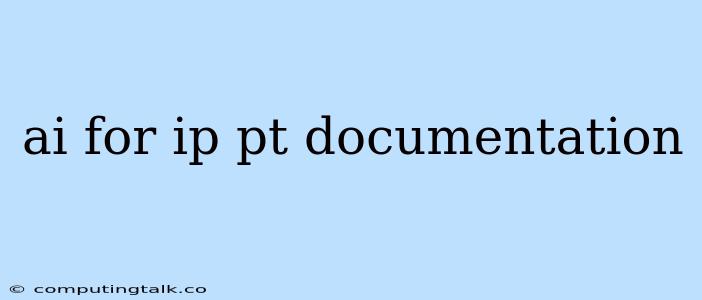The world of intellectual property (IP) is rapidly evolving, and artificial intelligence (AI) is playing a crucial role in this transformation. AI offers a powerful set of tools for automating and streamlining IP processes, from patent drafting to portfolio management. One key aspect of this evolution is the use of AI for generating and improving IP documentation. This article explores how AI can be used to create more efficient, effective, and accurate IP documentation.
What is AI-powered IP documentation?
AI-powered IP documentation refers to the use of AI technologies to automate and enhance the process of creating, managing, and utilizing IP documents. This includes tasks like:
- Patent drafting: AI can analyze existing patents, legal precedents, and technical data to generate draft patent applications. This can significantly reduce the time and cost associated with patent drafting, allowing for faster and more efficient filing.
- Patent analysis: AI can be used to analyze large datasets of patents, identifying trends, potential infringement risks, and opportunities for innovation. This can help companies make better informed decisions about their IP strategies.
- IP portfolio management: AI can organize and manage IP portfolios, ensuring compliance with regulatory requirements, tracking deadlines, and identifying opportunities for monetization.
How can AI help with IP documentation?
AI tools can significantly enhance the process of creating and managing IP documentation. Here are some key benefits:
- Increased Efficiency: AI can automate repetitive tasks, freeing up time for IP professionals to focus on more strategic work. This translates to faster turnaround times for patent applications and other IP documents.
- Enhanced Accuracy: AI can analyze vast amounts of data to identify inconsistencies and errors in IP documents, ensuring greater accuracy and reducing the risk of costly mistakes.
- Improved Clarity: AI can analyze the language and structure of IP documents, suggesting improvements for clarity and conciseness. This makes it easier for others to understand and interpret the information.
- Cost Reduction: Automating tasks through AI can significantly reduce the costs associated with IP documentation, making it more accessible to businesses of all sizes.
Key considerations for using AI for IP documentation
While AI offers significant advantages for IP documentation, there are important considerations to keep in mind:
- Data Quality: AI systems rely on high-quality data for accurate results. Ensure that the data used to train AI models is accurate, comprehensive, and relevant to the specific IP domain.
- Legal Compliance: It's crucial to ensure that AI-generated IP documentation adheres to all applicable legal requirements and standards. Seek legal counsel to ensure compliance.
- Human Oversight: While AI can be incredibly helpful, human oversight remains essential. IP professionals need to carefully review AI-generated documents, ensuring accuracy, completeness, and adherence to legal requirements.
What are the challenges of using AI for IP documentation?
Despite the potential benefits, using AI for IP documentation also presents challenges:
- Data Bias: AI models can be susceptible to biases present in the training data. It's crucial to address any potential bias in the data to ensure fairness and accuracy in AI-generated documentation.
- Security Concerns: Protecting sensitive IP information is essential. Ensure that AI systems are secure and comply with data privacy regulations.
- Transparency and Explainability: Understanding how AI systems arrive at their conclusions is crucial for trust and accountability. Ensure that AI-generated IP documentation is transparent and can be easily explained.
Examples of AI tools for IP documentation
Several AI tools are available to assist with IP documentation, including:
- Patent Drafting Tools: These tools use AI to analyze existing patents and other data to generate draft patent applications.
- Patent Analysis Tools: These tools leverage AI to analyze large patent datasets, identifying trends, potential infringement risks, and opportunities for innovation.
- IP Portfolio Management Tools: These tools use AI to organize and manage IP portfolios, ensuring compliance with regulatory requirements and tracking deadlines.
Conclusion
The use of AI for IP documentation is rapidly becoming an essential tool for businesses seeking to enhance their IP strategies. By leveraging AI, companies can create more efficient, accurate, and effective IP documentation, driving innovation and protecting their valuable assets. However, it's essential to carefully consider the challenges and address them effectively to maximize the benefits of AI and ensure its responsible use in the IP space.
